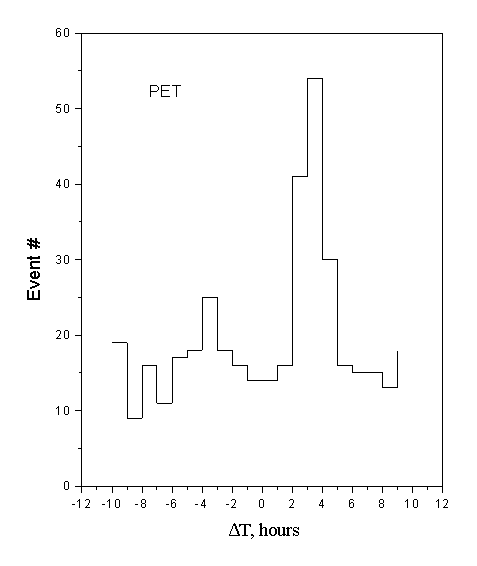[ ENGLISH ] [AUTO] [KOI-8R] [WINDOWS] [DOS]
[ISO-8859]
�


High-energy charged particle flux variations in vicinity of Earth
as earthquake precursors
A.M. Galper, S.V. Koldashov, A.M. Murashov, Yu.V. Ozerov, S.A. Voronov,
S. Aleksandrin,
Moscow State Engineering Physics Institute
1. Introduction
The existence of correlation between short-term variations (bursts) of high-energy charged particle fluxes in the near-Earth space and the seismic activity was pointed out in the end of eighties 1, 2. This conclusion was made on the base of results obtained in MARIA experiment on board SALYUT-7 orbital station. This experiment has been carried out in 1985.
Then, the detailed study of electron and proton flux variations under the radiation belt was continued by means of MARIA-2 magnetic spectrometer on board MIR orbital station, and by the instruments ELECTRON on board INTERCOSMOS-BULGARIA-1300 and METEOR-3 satellites3, 4. The results of these experiments confirmed the conclusion for correlation between short-term sharp increases of particle intensities and seismic processes. Moreover, it was found that the particle flux variations appeared 2-4 hours before the main shock of strong earthquakes5, 6. This means that the earthquake precursors in the near-Earth space were experimentally observed.
Using analysis of spatial distributions of particle bursts and strong earthquakes with magnitude more than 4, it was also shown that the forthcoming earthquake and its precursor (burst) are situated at the same drift shell.
The explanation of this phenomenon is connected with local disturbance of the particle flux in radiation belt caused by ultra low frequency (ULF) electromagnetic emission (EME), generated in forthcoming earthquake epicenter and propagated upwards into near-Earth space. It should be mentioned that frequencies of the YLF EME practically coincides with frequencies of bounce oscillations of high energy particles trapped by geomagnetic field.
This emission, as it was shown in some of ground-based experimental observations, was created in the earthquake epicenter several hours before the main shock7 and could propagate into magnetosphere8. There it interacts with particles trapped by geomagnetic field and results in particle precipitation from radiation belt. These precipitated particles drift around the Earth along L shell, which corresponds to the earthquake epicenter position9. The wave of precipitated particles is created by this process, and can make one or more revolutions around the Earth (GKV effect)6.
Later, in 1992, two experimental works dedicated to analysis of experimental data obtained on board METEOR-3A and OREOL-3 satellites were published. Authors searched for the seismo-magnetosphere correlations and confirmed the existence of mentioned above phenomenon10, 11.
Here we present the results of new analysis of short-term variations of high-energy charged particle fluxes on the base of experimental data of GAMMA and SAMPEX satellites, and comparison of these results with experimental data described above.
2. Instrumentation.
The brief description of instruments, used for searching for the seismo-magnetosphere correlations is presented below.
The MARIA and MARIA-2 instruments are magnetic time-of-flight scintillator spectrometers12 installed on board SALYUT-7 and MIR orbital stations (51 вХЯ inclination, 400 km altitude). These instruments provide detection and identification of protons, electrons and positrons in energy range 20-200 MeV. The measurements were carried out periodically from 1985 and are in progress.
The instrument ELECTRON 13 was installed on board METEOR-3 satellite (82 вХЯ inclination, 1250 km altitude). Using stack of scintillator detectors and Cherenkov counter, it registers electrons with energy more than 30 MeV. The measurements were carried out 1985-1986.
Russian-French gamma-ray telescope GAMMA-114 was installed on board astrophysical satellite GAMMA (51 вХЯ inclination, 350 km. altitude). In addition the main science information on gamma radiation, charged particle counting rates were registered, in particular, counting rate of electrons with energy more than 50 MeV. For this purpose the scintillator counters, time-of-flight system and gas Cherenkov detector were used in combination with lead scintillator calorimeter14. The measurements in orbit were carried out within 1990 - 1992.
SAMPEX15 satellite was launched into 82 вХЯ inclination 600 km altitude orbit in 1992. There is PET instrument16 on board. It consists of a stack of lithium-drifted-silicon detectors and carries out continuos studies of proton and electron fluxes up to now. We used SAMPEX Level 2 30 Second Count Rate data of PET electron channel (4-15 MeV) for search of seismo-magnetosphere correlations.
3. Data processing and analysis.
In order to separate charged particle bursts we used the counting rate data of instruments mentioned above. This information was attached to UT and this allows to know the spacecraft orbit parameters, to execute binding of particle count rates to geographical and L, B coordinates.
For the analysis we select sites of spacecraft orbits, which correspond to regions of the near-Earth space with L less than 2. Moreover, events inside South Atlantic Anomaly region were excluded, in order to decrease background flux and to increase the reliability of particle bursts selection, we choose B coordinate exceeding B0 value, corresponding to the geomagnetic field boundary of stable radiation belt.
Sharp, short-term increases of particle counting rates from tens of seconds to few minutes were selected as particle bursts if the counting rate exceeds 4 standard deviations from mean value of background flux.
Analysis of time correlation between particle bursts and strong earthquakes was carried out using the same procedure for all experiments. The strong earthquakes with magnitudes more than 4 from CNSS Catalog17 were selected in time range вХ† 12 hours around the time of particle burst observation. The value of time difference between earthquake beginning and particle burst D T=Teq-Tpb was calculated for every earthquake. We applied this procedure for all particle bursts. After the processing of all events, the distributions of D T values were built for every experiment. As an additional parameter, (value could be varied), we used the difference between L shell of earthquake and particle burst D L=Leq-Lpb. Using it we could take into account only earthquakes which were situated closely to particle burst in L space (used value were D L<0.2, or 0.1, or 0.05). It should be underlined that this cut is in correspondence with physical hypothesis of phenomenon. As it was mentioned above, the development of local magnetosphere disturbances caused by earthquakes occurs on L shell, which corresponds to earthquake epicenter.
4. Results.
The distributions of D T values, obtained using experimental data of GAMMA-1 and SAMPEX PET, are shown in fig 1. In order to compare them with results of previous experiments, the same distributions of D T obtained by MARIA-2 and ELECTRON are also presented in the same figure.
One can see that the shape of all four distributions are practically the same. This expresses in existence of obvious peak with mean position from 2 to 5 hours. The position of this peak in D T distributions means that the particle bursts can appear as a short-term earthquake precursor.
It should be underlined that for different earthquake magnitudes (M) and values of D L the confidence level of peak can significantly change. The value of this level varies from very high one if M>5, D L< вХ† 0.05 (fig.2) to low for uniform distribution if D L> вХ† 0.5. Putting cut on value D L> вХ† 0.5 means that only earthquakes, those L shells significantly differ from L shell of particle bursts, were taken for analysis. The uniform D T distributions were also obtained if year of experiments and earthquakes was randomly mixed.
5. Conclusion.
The results of the search for seismo-magnetosphere correlation in GAMMA-1 and SAMPEX PET experimental data have confirmed the conclusion about existence of interrelation between high-energy charged particle bursts in the Earth's magnetosphere and seismic activity, claimed in earlier MARIA-2 and ELECTRON experiments. This correlation opens the way for development of the new earthquake prediction method.
References
- Voronov S.A., Galper A.M., Kirillov-Ugriumov V.G. et al. Proc. of 20th ICRC, 1987, v.4, p.451-452;
- Voronov S.A. Galper A.M., Kirillov-Ugriumov V.G. et al. Cosmic Research, 1989, v.27, N.4, p.629-631;
- Galper A.M., Dmitrenko V.V, Nikitina N.V. et al. Cosmic Research, 1989, V.27, N.5, p.789-792;
- Voronov S.A., Galper A.M., Koldashov S.V. et al., Cosmic Research, 1990, v.28, N.5, p.789-791;
- Aleshina M.E., Voronov S.A., Galper A.M. et al. Cosmic Research, 1992, v.30, N.6, p.79-81;
- Galper A.M., Koldashov S.V., Voronov S.A. Adv. Space Research, 1995, v.15, p.131-133;
- Fraser-Smith A.S, Bernard A., McGill P.R. Geophys. Res. Lett, 1990, v.17, N 9, p.1465-1468.
- Molchanov O.A. et al. Cosmic Research, v.32, N.4-5, p.150, 1994.
- A.M. Galper, S.V. Koldashov, L.V. Maslennikov, A.M. Murashov et al. Proc. of 25th ICRC, 1997, v.2, p.349-350;
- Pustovetov V.P., Malyshev A.B. Cosmic Research, v.31, n.5, p.84-87, 1993.
- Galperin Yu.I. et al, Cosmic Research, v.30, n.1, p.89-92, 1992.
- Voronov S.A., Galper A.M. Koldashov S.V. et al, Pribori i Tehnika Eksperimenta, 1991, N.2, p.59-63;
- Galper A.M. et al, Cosmic Research, v.21, N.5, p.707-709, 1983.
- Akimov, V.V., V.M. Balebanov, A.S. Belousov et.al. Cosmic Science Review, 1988, N.49, p.111-124.
- Baker, D.N., G.M. Mason et al. IEEE Trans. Geosciencies and Remote Sensing, 31, 531, 1993.
- Cook, W.R., A.C. Cummings et al. IEEE Trans. Geosciencies and Remote Sensing, 31, 535, 1993.
- URL http://www.geophys.washington.edu/CNSS
|
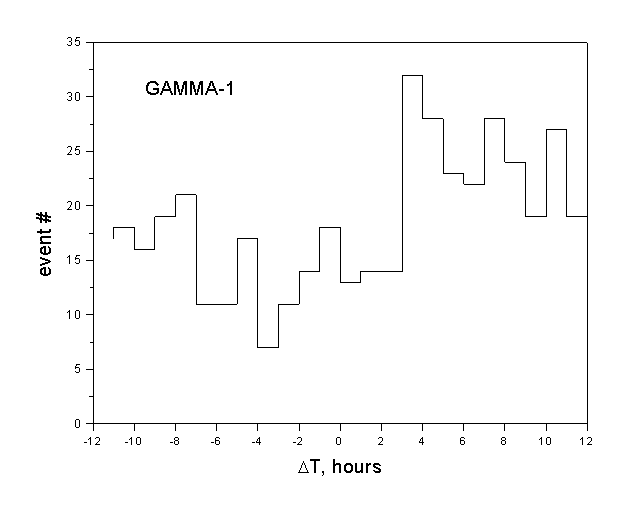
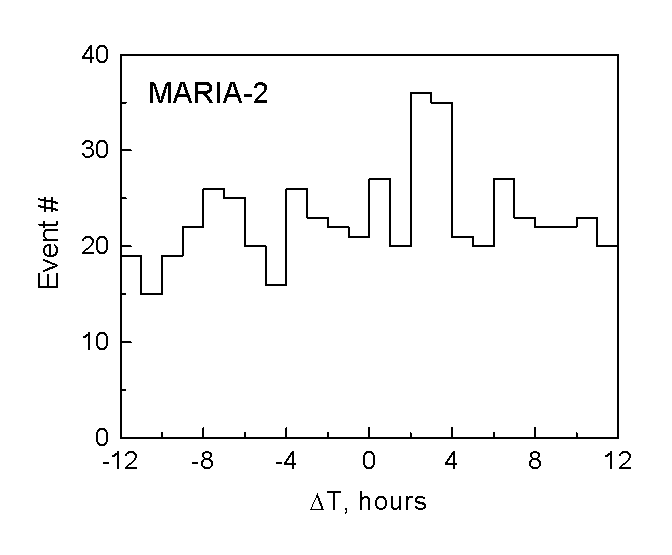
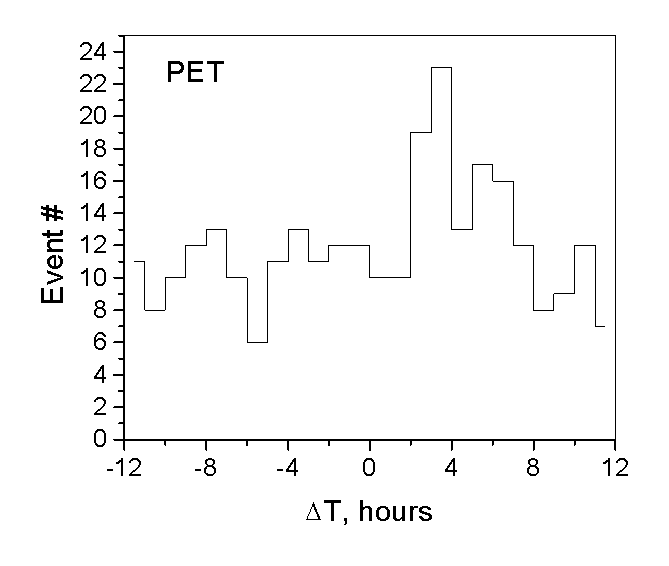
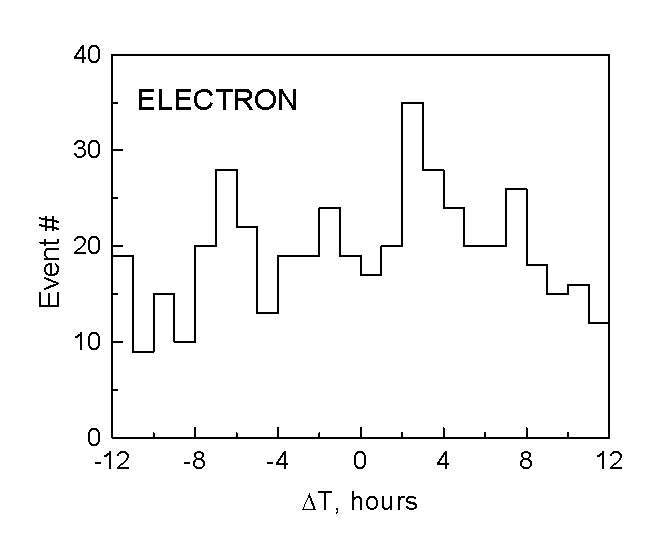
Fig. 1 D T distributions, obtained in GAMMA-1, SAMPEX PET, MARIA-2 and ELECTRON experiments (M>4, D L< вХ† 0.1).
|




Fig.2 D T distribution, obtained on board SAMPEX (M>5, D L< вХ† 0.05)


Copyright (c) "–†—Г—Б—Б–Ї–Є–є –њ–µ—А–µ–њ–ї–µ—В"








